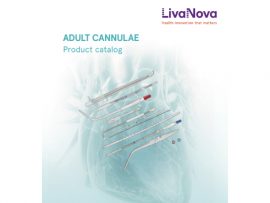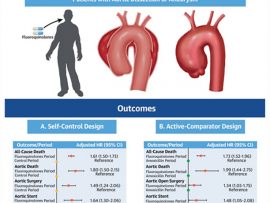Abstract Introduction Cardiac surgery with cardiopulmonary bypass (CPB) often induces systemic inflammatory reaction syndrome (SIRS), affecting postoperative outcome. We aimed to explore adaptive/maladaptive inflammation using unsupervised machine learning. Methods We..
Lee masAbstract Background Amniotic fluid embolism is a rare potential complication in the peripartum period. Case Summary A 27-year-old nulliparous woman presented for elective induction at 41 weeks' gestation. Due to..
Lee masAbstract Cardiopulmonary bypass serves as a cornerstone in cardiac surgery, enabling life-sustaining circulatory and respiratory support during complex procedures that necessitate the temporary cessation of cardiac activity. This intricate process..
Lee masAbstract Purpose Extracorporeal cardiopulmonary resuscitation (ECPR) is an advanced resuscitation therapy for cardiopulmonary arrest refractory to standard CPR. ECPR treatment recommendations are not supported by strong evidence, and institutional criteria..
Lee masAbstract Objectives To describe the associations between perioperative blood pressures and clinical postoperative outcomes, and to investigate if these associations depend on the preoperative resting and nadir nighttime blood pressures...
Lee masAbstract Purpose To assess whether prone positioning (PP) increases bleeding risk compared to supine positioning in ARDS patients undergoing veno venous Extracorporeal Membrane Oxygenation (VV ECMO). Materials and Methods A..
Lee masAbstract Background Acute normovolemic hemodilution (ANH) and retrograde autologous priming (RAP) are blood conservation techniques designed to reduce transfusion requirements. Purpose This study evaluated the impact of combining ANH and..
Lee masAbstract Background Intraoperative blood salvage can reduce the need for allogeneic blood transfusions, minimizing immunological risks and infection by reusing the patient's own blood. However, in cancer surgery, a key..
Lee masAbstract We read the interesting work of Romero‑Garcia and colleagues on the association between partial pressure of O2 in arterial blood (PaO2) and neurological outcomes in a context of acute brain..
Lee masAbstract Extracorporeal cardiopulmonary resuscitation (ECPR) for refractory cardiac arrest is increasing in usage, but risk factors for seizures are largely unknown. We included adult ECPR patients in the Extracorporeal Life..
Lee masAbstract This study aimed to assess whether the proinflammatory markers procalcitonin (PCT), C-reactive protein (CRP), or interleukin 6 (IL-6) are associated with mortality in neonates with congenital diaphragmatic hernia (CDH)..
Lee masAbstract Venovenous extracorporeal membrane oxygenation (VV ECMO) relies on effective blood drainage, and cannula design plays a crucial role in optimizing blood oxygenation. Recirculation, where oxygenated blood returns to the..
Lee masAbstract Extracorporeal membrane oxygenation (ECMO) is a fundamental treatment for cardiovascular and severe pulmonary diseases, with small animal models providing critical insights into organ protection during cardiopulmonary bypass and ECMO..
Lee masAbstract Extracorporeal membrane oxygenation (ECMO) is a mechanical circulatory and respiratory support system that facilitates gas exchange and hemodynamic stabilization through an external circuit. ECMO has been increasingly utilized for..
Lee masAbstract Objectives: We examined data from the International Registry of the Extracorporeal Life Support Organization to identify risk factors for mortality in pregnant and peripartum patients receiving extracorporeal membrane oxygenation...
Lee masAbstract Lower limb malperfusion for type A acute aortic dissection (ATAAD) is a challenging complication, particularly when it occurs suddenly during the operation. We report a 76‐year‐old female with ATAAD..
Lee masAbstract Background Postoperative respiratory failure following cardiac surgery (CS-PRF) remains a critical complication with substantial morbidity and mortality. Current risk prediction models are limited by static assessments and suboptimal accuracy...
Lee masAbstract Introduction Extracorporeal cardiopulmonary resuscitation (eCPR) is a rescue therapy for refractory cardiac arrest, with evidence suggesting improved outcomes when performed at experienced centres. Unlike conventional CPR (cCPR), eCPR patients..
Lee masAbstract Cardiac surgery is a commonly performed procedure worldwide, with an estimated 1–1.5 million cases per year and figures destined to increase in the next few years []. A significant..
Lee masAbstract Implantations of (VADs) have significantly improved and life expectancy of end-stage heart failure patients. However, despite the advancements in the VAD designs and patient management protocols, the VAD recipients remain at..
Lee masAbstract Cardiac surgery-associated acute kidney injury (CSA-AKI) is a common complication following cardiac surgery. Despite growing awareness of sexual dimorphism in cardiovascular and chronic kidney disease, little is known about..
Lee masAbstract Venoarterial extracorporeal membrane oxygenation (VA-ECMO) serves as a critical mechanical circulatory support modality, sustaining systemic circulation in cases of severe cardiac failure or cardiac arrest. While VA-ECMO improves hemodynamics,..
Lee masAbstract Background The safety and efficacy of prophylactic corticosteroid administration during the perioperative period of cardiac surgery have undergone extensive and comprehensive examination. In this study, we conducted a bibliometric..
Lee masAbstract Purpose of review After more than 50 years from its invention, the intra-aortic balloon pump (IABP) is still one of the most widely used mechanical circulatory support devices to..
Lee masAbstract Importance Studies suggest that everolimus may reduce the risk of rejection, cardiac allograft vasculopathy (CAV), chronic kidney disease (CKD), and cytomegalovirus (CMV) after heart transplant. Everolimus use is controversial because..
Lee masAbstract Nutritional support in pediatric patients receiving extracorporeal membrane oxygenation (ECMO) therapy is controversial. Although ECMO is increasingly used in pediatric intensive care units, there is no consensus on the..
Lee masAbstract Background Intraoperative hypotension (IOH), defined as a mean arterial pressure (MAP) below 65 mmHg, is a common complication during surgery and is associated with significant postoperative morbidity, including acute..
Lee masAbstract Veno-arterial extracorporeal membrane oxygenation (ECMO) brings many monitoring pitfalls due to the countercurrent blood flow, which may create left ventricular overload and perfusion imbalances between the two cerebral hemispheres...
Lee masAbstract Background Prior clinical research demonstrated that rapid reduction in arterial carbon dioxide (PaCO2) levels during extracorporeal membrane oxygenation (ECMO) is associated with acute brain injury (ABI), which may be..
Lee masAbstract Background Cardiac surgery-associated acute kidney injury (CSA-AKI) is a notably common complication in pediatrics, with an incidence rate ranging from 15 to 64%. This rate is significantly higher than..
Lee mas



















